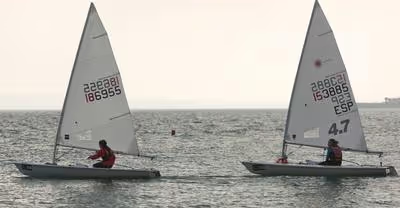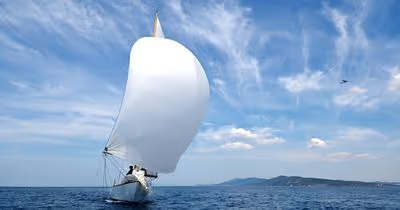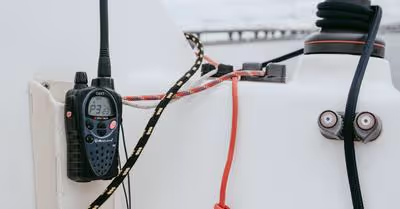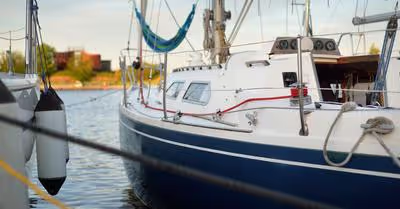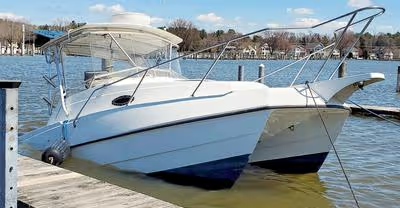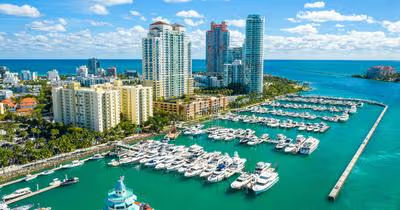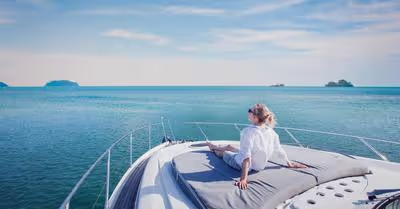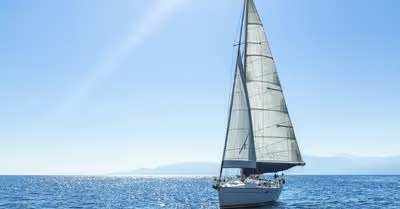Table of Contents
Main Keel Types
Depending on your sailboat, there is likely a keel with it. If it does not have one, then it would be difficult to add since this is usually the first step in building a boat.
The keel is meant to combat the heel of a boat rocking side to side from the wind and water. The increased buoyancy and weight help keep the boat stable.
When searching for a boat, or if you already have one, it is important to know what type you have. Each keel has unique features that allow you to sail a bit differently.
Full Keel
Full keels run the entire length of the sailboat, or at least 50 percent of it from the front to the aft. It is fully integrated into the boat, just like it shows on an Island Packet 380.
This keel type is the heaviest of them all and has the largest wetted surface. This allows you to remain stable in a given direction but also reduces heeling.
The only drawback is that it is the slowest ride, even though it is the most comfortable. It offers some of the worst performance when it comes to being fast.
If you travel full time and live aboard your boat, a full keel is likely the option for you. Most sailors that prioritize comfort over speed will likely opt for this type of keel.
If you want slightly more speed without compromising the stability of the boat, a modified full keel is your next best option. These offer slightly better performance and handling than typical full-length keels.
These are still full length, but the front is cut out, which reduces the wetted surface. This is the next best option for comfort and stability, as you would see in a Nicholson 32.
A modified full-length keel is very popular among bluewater cruisers. Usually, these boats have a skeg to help protect the rudder in the event you find shallow water a little too quickly.
Bulb Keel
This keel type is within the family of fin keels, but with a unique shape at the end such as a bulb or a teardrop. Increased ballast greatly improves stability and does well with the distance between the regular force and counterforce.
Since the design does not need the use of a deeper fin, it allows it to have a shoal draft. This keel type does remarkably well in cruisers since the distance between the force of the sails and the weight of the keel makes the boat more stable from heeling.
In addition to the weight, this keel also creates a less wetted surface from its design. This will increase comfort while sailing in a huge way compared to other keels.
Bilge Keel
A bilge keel might be one of the more versatile keels if you enjoy going in shallow waters. With a bilge keel, there are actually two fins that run along the length of the boat that allows it to be beached, if desired.
These keels have double the amount of wetted surface, which makes for a comfortable ride with increased directional stability. With better designed I’ve the years, they have also improved windward performance and decreased heel.
Compared to a fin keel, they are slightly slower but do not compromise overall performance. If you happen to have an older design, you might notice performance issues compared to a newer boat with a bilge keel.
Bilge keels are often seen in tidal waters since those boats can be beached. You will often see fishermen along British coastlines or sailors using these types of boats with that keel.
Wing Keel
This keel type is a variation of the fin keel that has a unique horizontal shape, looking similar to a wing. These generally have a good weight to them and allow them to reduce cross flow, improve stability for direction, and the ballast decreases any heel.
You will likely see wing keels on bluewater cruisers since their design better suits directional stability versus other keels. For example, the most famous use of the wing keel was on Australia II back in the 1983 America’s Cup race.
This type of keel has mixed results depending on what you are trying to accomplish. It allows for a lower center of gravity, easier access for maintenance, and a stiffer ride with a shallow draft.
However, it features one of the worst performances overall when trying to point windward, has shorter rudders, and getting stuck aground is a nightmare. Most sailors would simply prefer just a fin keel so you do not lose any performance windward.
Fin Keel
If you have ever seen a boat out of the water and noticed a blade somewhere in the middle, then this is a fin keel. This keel type allows the boat to be lighter and faster.
Since there is more distance between the ballast and sails, it reduces the wetted surface or having to add more ballast. These are also deeper and lighter underneath the boat and greatly improves speed.
With increased speed, you are giving up some comfort in your experience. These keels allow more heel and less direction stability.
If you happen to run aground, you will likely break or heavily damage this keel type. You can see this keel commonly with racers and cruisers, especially in the Hunter 34.
There are two additional variations of the fin keel, one with a skeg rudder and the other with a spade rudder.
The skeg rudder has a smaller structural part in front of the rudder to protect it. This helps with speed and safety without making it less vulnerable.
As for the spade rudder, it is completely exposed with a fin that is bolted on. The keel is not integrated in the hull, which makes it less comfortable and more vulnerable.
Other Keel Types
As you can see, there are a handful of different types of keels. Each one has a unique benefit that makes them stand out from another one.
There are additional keel types that you will find in smaller boats and not particularly used in bluewater sailing. Depending on the type, they have their own benefits as well.
Lifting Keels
A lifting keel sounds exactly like their name suggests, which is a keel that can lift up and down. There are two main types of lifting keels known as centerboard and daggerboard.
Centerboard
This type of lifting keel is retractable and sits on a hinge that allows it to be lowered up and down in a slot through the hull. Think of this like a pocket knife blade coming out underneath the boat.
You can easily adjust the draft of the boat by increasing or decreasing how much you need. These are typically found on smaller fishing boats, so rougher waters might not be ideal to sail.
Since this keel type allows you to make adjustments, it is very versatile. Through adjustments, you can take your boat into shallow waters but also help steady it in larger bodies of water.
Daggerboard
This other main type of retractable lifting keel can be lowered up and down within a slot in the hull. Unlike the design by the centerboard, the daggerboard lowers straight down and gives you the freedom to increase or decrease the draft on your boat.
While lowering the daggerboard, you are effectively decreasing heel and improving your directional stability. This design is something you will typically find on daysailers.
Even as simple as this design sounds, it is not commonly found on larger boats. The daggerboard is wooden and carried within the hull, so it is not attached.
Leeboard Keel
Leeboards are similar to lifting keels since they can move. However, these keels are attached to the side of the hull and they pivot.
Due to their unique design and location on the boat, they generally are used to help with slippage to leeward. Since that is the main priority of this keel type, the name suits it well.
They do not typically sit below the waterline and are unweighted, so they do not decrease heel at all. These are best used in boats that remain in shallow or tidal waters.
One of the main advantages of having a leeboard instead of a keel is that it allows the boat to have a shoal draft. The boats that do not have a keel but have a leeboard are typically flat on the bottom and remain stable on calm waters.
This also gives the boat the ability to be beached. A good example of a boat that uses a leeboard would be a Dutch or sailing barge. They travel along shallow waters and a leeboard helps combat the wind.
Canting Keel
This type of keel sits on a hydraulic hinge underneath the boat and is used to move windward. Sailors will use the keel’s position to help combat the force of the sails.
Maneuverability is increased while the wetted surface decreases. The weight of the keel also makes a big difference to help in this process.
Canting keels are usually found on high-performance sailing boats and are not yet established on cruisers. The need for hydraulics and plenty of moving parts under the boat cause concerns for trying to fix them. In addition, this keel is vulnerable compared to others and is difficult to fix when they do break.
This keel promises increased maneuverability and better performance overall. However, it might be a long time before the design gets a final tune up for sailors to trust it.
The Importance of a Keel
When searching for a boat, it is important to know what type of keel it has. The type of keel will allow you to make a better decision as to what your sailing goals are.
For example, you would not want to purchase a boat that has a full keel if you enjoy going to shallow waters in your boat. For that, you would likely need to purchase one that either has a bilge or bulb keel.
The keel is meant to help with stability and control, with many variations to provide different options. Depending on your sailing goals, there is likely a keel to fit your needs.
Keels help combat a boat righting and sideways movement. It also helps the boat's ballast, giving it a weight that keeps the boat from capsizing.
Other boats use keels to help with performance, but not in the same setting as sailboats. A trawler boat that is used for fishing, for example, has a large rectangular piece of metal along the boat’s hull known as a bar keel. This helps keep the boat down with the added weight and allows better control when navigating.
Without a keel, a boat is subject to the conditions that it is in. Heavy wind or unfavorable sailing waters could be trouble for a boat that does not have a keel.
Unless you have a multi-hull or a smaller boat used mainly for shallow waters, the use of a keel is not needed. This is why catamarans do not have a keel, due to the structure of that boat in general helps with stability.
In some dinghies, these boats might have a centerboard or daggerboard keel that will swing in the water. Since these boats are smaller, like racing dinghies, the weight of the keel does not matter that much since flipping one of these is not a huge deal.
Disadvantages of a Keel
One of the main problems with having a keel is that it can be damaged when taking out or putting it into the water. Even though the material should be strong enough to handle any damage, you still do not want to abuse the keel so much that it breaks or prevents you from using it to its potential.
Some keels allow for traveling through shallow water, while others are meant to be in deeper areas. The best thing you could do, if you have to get it in or out of the water, is to be as deep as possible.
The disadvantages of a keel are nowhere near the importance of having one. Depending on the keel that your boat is equipped with will determine the style of sailing you should stick to.
Material of a Keel
A keel is likely the same material that the hull itself is made out of. The keel is usually the first design step, so the rest of the hull will typically match.
In most cases with fiberglass boats, the keel will be weighted down with lead and then covered with fiberglass. This gives the boat the functionality of the keel but also matches the hull.
Whichever material it is made out of, it simply has to match the pressure and force that is going to be put on it. Since it is constantly moving in and out of directional changes, it needs to be able to withstand that.
The hull will be able to stand up to this type of beating, so you need a keel that can also take the pressure. It also needs to be strong enough to handle being taken out of the water. Any weaker material will break simply getting the boat in or out of water.
Maintaining Your Keel
Just like other areas of your boat, your keel needs proper care too. It might be easy to forget since you do not see it all the time, but if you were to get on a boat without a keel, you will definitely remember a keel every time.
If you live on your boat, you are likely going to have to clean your keel a little more often than someone that takes it out once a weekend. A general rule of thumb is to clean your keel about once or twice a season or inspect it each time you are going to put it in the water.
The keel is hit with just about everything that floats around in the water. If you have a fin keel, you are likely to have kelp and seaweed wrapped around it.
For this scenario, you could easily buy the tools to dive in the water and cut away the debris. Keep in mind that you are going to want to do this in shallow water and have someone with you as a safety precaution.
In addition, you probably want to purchase flags or some indicator that divers are present. This way you can let other sailors know to take it easy if around a marina.
If you have to take your boat out of the water, then this would also be a good time to add additional paint to your keel. On top of that, it is a good opportunity to inspect your keel for any cracks or damage in case you run aground in the past. If you notice large cracks or if your keel is loose, it might be a good time to get a professional to look at it.
Even though no one is going to see your keel while your boat is in the water, you still need to treat it with respect. It is crucial that you take care of your keel just like you would any other part of your boat that requires maintenance. After all, it is one of the biggest reasons why you purchased that boat in the first place.
How to Find the Perfect Keel
Every sailor is going to have their own taste when it comes to the style of sailing they want to achieve. This boils down to speed, comfort, and being able to move around freely.
Depending on the outcome you are wanting to experience, there are different characteristics at play with the variations of keels. For example, if you are living on your sailboat, then you are likely going to want comfort over everything else.
When it comes to the best for each situation, these keels have been preferred by sailors:
- Bluewater cruisers are best equipped when they have a modified full keel or fin keel with a skeg rudder
- Liveaboards that are coastal prefer a full keel, while liveaboards on inland waters would rather have a flat bottom boat equipped with a leeboard.
- Daysailors on the coast will usually use a centerboard or a fin keel with a skeg rudder
- When it comes to racing, a wing or fin keel is the best option
Full keels are going to offer the best reliability in terms of being stable and offer the best heel reduction. However, if you want something that provides similar benefits without compromising speed, a fin keel will work wonders.
The goal is to find a boat that is going to suit your needs and the keel to match your desired outcome. If you can pinpoint exactly how you want to sail, then your next step is to find the keel design that works for you.
Recent Articles



